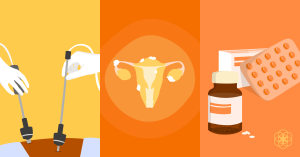Illustration: Emma Günther
How common is endometriosis?
Why is the “missed disease” so hard to diagnose?
Endometriosis is a painful, long-term condition where the endometrial tissue that typically lines the uterus grows in other parts of the body where it should not be (1). It has been called the “missed disease” because of its inconsistency in diagnosis and treatment (2). Studies have shown that the average time to get a diagnosis for endometriosis is many years. One Brazilian study showed an overall average time of seven years to diagnosis (3), and other studies of populations in the UK and USA have found diagnostic delays of 8 and 12 years, respectively (4). The delay is longer in places where healthcare is funded by the government compared to places where it’s funded by insurance or self-funded (5).
According to research, 6 out of 10 people with endometriosis have not been diagnosed yet (6). Overall, this condition has historically been ignored by government policy and research funding (2). Promoting conversation about endometriosis can support people who have it or think they have it, by bringing attention to a commonly “missed disease” (2,7).
How common is endometriosis?
Endometriosis is a common gynecological condition that affects 190 million people worldwide (1). That’s about 1 out of every 10 women of reproductive age (1). The number of people with endometriosis may be even higher because of the delay people experience in receiving a diagnosis (6). Research indicates that the overall prevalence of endometriosis is about 18% (8). That means that it is believed that even more people than those with diagnoses live with the condition.
Many people with endometriosis never develop symptoms (1), which makes it difficult to accurately estimate how many people have it. One study found that 23% of participants with endometriosis developed no symptoms (8). This suggests that endometriosis rates may be higher than suspected (8). Further research is needed to determine how many people have the condition.
The struggle to get a diagnosis for endometriosis
Symptoms vary between people
Symptoms of endometriosis can be different for each person, which may make it difficult to diagnose (1). Healthcare providers may need additional training to recognize the range of symptoms (9). In a recent study, a quarter of providers felt they knew too little about endometriosis for clinical practice (9).
Sometimes, the symptoms of endometriosis can mirror other conditions (1,10). Symptoms of endometriosis include dyschezia, painful bowel movements, and dysuria, painful urination (11). Because the range of symptoms of endometriosis is so wide, a diagnosis cannot be made based on symptoms alone (11). A 2012 study in Austria found that almost three-quarters of participants were misdiagnosed before being correctly diagnosed with endometriosis (9).
People with endometriosis may think pelvic pain and dysmenorrhea, painful menstruation, is typical, especially if they’ve experienced it their whole lives (10). On top of this, many healthcare providers may not recognize it as a hallmark symptom of endometriosis (1). This can lead to delays in receiving a diagnosis (11). In one study, almost half of the participants saw at least five healthcare providers before being diagnosed with endometriosis (9).
Infertility, hormonal changes, and gender identity can affect your diagnosis
Between 30–50% of infertile people have endometriosis (11). Sometimes people will only be diagnosed with endometriosis when they are tested for infertility (12). Many people only learn that they have endometriosis after seeking care for infertility or surgery for another condition (10).
Sometimes, changes in hormones can temporarily stop endometriosis symptoms. This can further delay a diagnosis as some people believe their endometriosis is cured. Hormone therapies, like the pill or progestins, can suppress the pain associated with endometriosis (1). Additionally, pregnancy and frequent breastfeeding can delay menstruation and suppress menstrual-associated symptoms (9,13). When menstruation returns, endometriosis symptoms often do, too (8,10).
Transgender and non-binary people affected by endometriosis may find it harder to receive a diagnosis and appropriate healthcare (14). They may view endometriosis as a female-specific condition and avoid treatment (14). It’s not uncommon for this population to be diagnosed with endometriosis during a gender-affirming hysterectomy after living for years with the disease (15).
Surgery is the most definitive way to get an endometriosis diagnosis
Endometriosis can be difficult to diagnose, even if a person and their doctor suspect it (16). The gold standard for diagnosing is a key-hole surgical procedure called a laparoscopy (10). It’s the most accurate way to diagnose, but even then, it can be difficult to see the endometrial tissue and not every healthcare provider offers it (16).
This procedure is expensive, which can be challenging for people with limited incomes, and sometimes the procedure itself is unavailable (1). Some people may be nervous about the surgery, which could cause further diagnosis gaps. And like any surgery, there is a risk of complications (16).
A transvaginal ultrasound, an image taken through the vagina, can also be used as the first choice for diagnosing endometriosis (17). Doctors can use another type of scan, an MRI, to diagnose some types of endometriosis (17). Transvaginal ultrasound or MRI can help diagnose suspected endometriosis, but they are not as accurate as a laparoscopy (11,18). As more accessible methods are used to diagnose it, endometriosis may become more identifiable (16).
Is endometriosis more common in certain populations?
Endometriosis is a worldwide condition, but different parts of the world may experience higher rates due to differences in access to health and knowledge surrounding the disease (1). In lower-income areas, equipment for an accurate diagnosis may be unavailable and some physicians may not be adequately trained (1).
Research suggests that Asian women are more likely to be diagnosed with endometriosis than white, Black, or Hispanic women (19). It’s difficult to know if these populations have higher rates of endometriosis, or if they have better access to the tools used to diagnose the disease (19).
Studies that look at how weight influences whether or not a person has endometriosis have been inconclusive. One study found that people with high body mass indexes (BMIs) may be less likely to have endometriosis than people with a lower BMI (20). This could be due to hormonal variations associated with weight (20). Another observational study showed that people with a higher BMI had more severe endometriosis (21). Yet another study found that people with a high BMI may be less likely to be diagnosed with endometriosis than people with a low BMI (22). The results of these studies show us that more research, awareness, and access to diagnosis and treatment are needed worldwide to determine the prevalence of endometriosis better.
Do you have endometriosis symptoms?
If you notice menstrual or pelvic pain that interferes with your daily life, see your healthcare provider (1). If you think you may have endometriosis, track your symptoms in the Clue app, and take the data to your healthcare provider. They will understand your cycle patterns better and may support a faster diagnosis.
In the Clue app, you can track different types of pain, pain levels, and other symptoms and cycle-related experiences. If you’re subscribed to Clue Plus, you can use the Analysis Tab to get additional insight and data visualization into your cycle statistics. You can also toggle on your confirmed diagnosis in the My Health Record section in the Clue App to contribute to important reproductive health research and help Clue close the diagnosis gap.
Advocacy, research, and education will continue to bridge the gap in diagnosing this “missed disease”. If you’re looking for additional support, there are support organizations that specialize in endometriosis, like the Endometriosis Foundation of America or Endometriosis UK
Article originally published on March 27, 2018.

